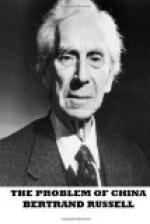In the Treaty Ports, Europeans and Americans live in their own quarters, with streets well paved and lighted, houses in European style, and shops full of American and English goods. There is generally also a Chinese part of the town, with narrow streets, gaily decorated shops, and the rich mixture of smells characteristic of China. Often one passes through a gate, suddenly, from one to the other; after the cheerful disordered beauty of the old town, Europe’s ugly cleanliness and Sunday-go-to-meeting decency make a strange complex impression, half-love and half-hate. In the European town one finds safety, spaciousness and hygiene; in the Chinese town, romance, overcrowding and disease. In spite of my affection for China, these transitions always made me realize that I am a European; for me, the Chinese manner of life would not mean happiness. But after making all necessary deductions for the poverty and the disease, I am inclined to think that Chinese life brings more happiness to the Chinese than English life does to us. At any rate this seemed to me to be true for the men; for the women I do not think it would be true.
Shanghai and Tientsin are white men’s cities; the first sight of Shanghai makes one wonder what is the use of travelling, because there is so little change from what one is used to. Treaty Ports, each of which is a centre of European influence, exist practically all over China, not only on the sea coast. Hankow, a very important Treaty Port, is almost exactly in the centre of China. North and South China are divided by the Yangtze; East and West China are divided by the route from Peking to Canton. These two dividing lines meet at Hankow, which has long been an important strategical point in Chinese history. From Peking to Hankow there is a railway, formerly Franco-Belgian, now owned by the Chinese Government. From Wuchang, opposite Hankow on the southern bank of the river, there is to be a railway to Canton, but at present it only runs half-way, to Changsha, also a Treaty Port. The completion of the railway, together with improved docks, will greatly increase the importance of Canton and diminish that of Hong-Kong.
In the Treaty Ports commerce is the principal business; but in the lower Yangtze and in certain mining districts there are beginnings of industrialism. China produces large amounts of raw cotton, which are mostly manipulated by primitive methods; but there are a certain number of cotton-mills on modern lines. If low wages meant cheap labour for the employer, there would be little hope for Lancashire, because in Southern China the cotton is grown on the spot, the climate is damp, and there is an inexhaustible supply of industrious coolies ready to work very long hours for wages upon which an English working-man would find it literally impossible to keep body and soul together. Nevertheless, it is not the underpaid Chinese coolie whom Lancashire has to fear, and China will not become a formidable competitor until improvement in methods and education enables the Chinese workers to earn good wages. Meanwhile, in China, as in every other country, the beginnings of industry are sordid and cruel. The intellectuals wish to be told of some less horrible method by which their country may be industrialized, but so far none is in sight.




